Last updated: November 27, 2024
Article
Bighorn Sheep in Nebraska

NPS/Robert Wagner
Audubon's Bighorn Sheep
When most people think of bighorn sheep (Ovis canadensis), they likely think of the sheep climbing steep, rugged mountain terrain in the Rocky Mountains. However, bighorn sheep are native to the plains and bluffs of western Nebraska. Before the year 1900, a subspecies known as Audubon's bighorn sheep (Ovis canadensis auduboni) roamed parts of western Nebraska, including the Pine Ridge of the northwestern part of the state and the Wildcat Hills in the area near Scotts Bluff. In fact, emigrant James Tolles wrote in the trail journal of his 1849 journey that "(Scotts Bluff) is near 600 ft in height; and we had much difficulty in ascending it, but was well repaid for our trouble, upon this rock we found pine trees, grass, and some very nice flowers. We saw upon this bluff over 50 mountain sheep." Unfortunately, the Audubon's subspecies of bighorns was likely reduced to extinction in the early 1900s due to disease, habitat loss and hunting.
NPS/Robert Wagner
Bighorn Sheep Description
Bighorn Sheep are named for the large, curved horns on the heads of the males (rams).While female bighorns also bear horns, female horns tend to be shorter, with a less pronounced curve. Their fur ranges from light brown to chocolate, with a white rump. Males are the larger of the sexes, with adults weighing from 125 to 300 pounds and standing up to 3.5 feet tall. Females, known as ewes, typically weigh 75 to 200 pounds and stand up to 3 feet tall.Bighorn sheep live in large herds. Unlike their relatives, the domesticated sheep, bighorns do not follow a single leader ram. As the mating season, or rut approaches, rams attempt to establish dominance by engaging in "headbutting" behavior. The winner of these clashes earns the right to mate with female, usually in November. After a 6 month gestation period, bighorn lambs are born in May. The newborn lambs weigh 8 to 10 pounds and have the ability to walk within a few hours after being born.
Bighorn sheep graze on grasses and browse on the leaves and twigs of shrubs. Predators of bighorn sheep include coyotes, foxes and bobcats. Lambs are much more susceptible to predation than adults.
Bighorn Sheep are Reintroduced to Western Nebraska
In 1981, the Wildlife Division of the Nebraska Game and Parks Commission reintroduced Rocky Mountain bighorn sheep back into the state. The first group of reintroduced sheep came from Custer State Park in South Dakota and included 2 males and 4 female sheep. These six individuals were moved to a 500 acre captive enclosure in Fort Robinson State Park in northwestern Nebraska.Since the intial reintroduction, four additional bighorn sheep herds have been established in the Panhandle of the state including two herds in the Wildcat Hills south and southwest of Scotts Bluff National Monument. These two local herds include the Hubbard's Gap herd which was established in 2007 with 51 sheep, and the Cedar Canyon herd which was established in 2001 with 22 individuals.
While the initial reintroductions were successful, disease has impacted all of the bighorn herds in Nebraska. The Wildcat Hills herds, however, seem to have fared better and as of 2019 nearly 80% of the bighorn sheep living in the state were found in this location. The diseases that have the greatest negative impacts on bighorn sheep in Nebraska include: contagious ecthyma, epizootic hemorrhagic disease or bluetongue virus, scabies, anaplasmosis, Johne’s disease, brucellosis, and pneumonia. Pneumonia is most prevalent among the herds and results in large scale die of of the sheep, followed by multiple years of lamb mortality.

NPS/Eric Grunwald
